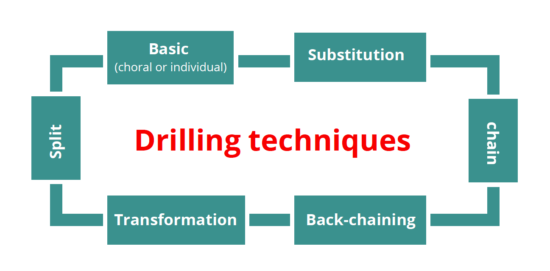Drilling in language learning simply means listening to a language model and repeating what is heard. The language model (or structure or pattern) can be provided by a teacher, a friend, another student or a recording. Even though modern language learning tends to be rather student-led than teacher-led, drilling can be a good way to support your learning process and to help you to internalize particular structures of the target language in a very simple way. Nonetheless, this simplicity might be a bit boring as mindless listening and repeating normally does not really challenge your language production and leads you to a rather passive role. Therefore, in this article we present you some modifications of drilling that can pep up your learning and which you could integrate in your learning routine easily.
Which elements of a target language are concerned by drilling techniques?
Drilling affects many parts of a language in its oral representation. Intonation, grammar, vocabulary or pronunciation: depending on the content of the drilling exercise and the particular type of modification it offers a great variety of possible and personal ways to reach your learning targets. Generally, it is important that the structures you want to internalize are accurate. Drilling techniques are based on imitation. Therefore, with a particular focus on pronunciation, these techniques are most effective when the initial content is presented by a native speaker. As a EFL learner drilling is also a good alternative but might afford a little preparation before you start.
Six easy drilling techniques to improve your English skills
Basic drills: A person says something and a group of people (choral repetition) or an individual (individual repetition) repeats the sentence. To make this basic technique more lively these modifications are useful: whispering the sentence, or repeating it very loudly. It also can be repeated in a very high or very low voice.
Substitution drills: One person supplies a sentence e.g. „Learning English in the sun is so much fun!“. In this sentence, one part (bold) is furthermore replaced by different alternatives. In this case the leading person does not repeat the whole sentence but only says the word or group of words for the replacement.
Transformation drills: In this case the transformation refers to grammatical aspects of the sentence. The leading person provides a sentence, e.g. „Learning English is so much fun!“ Then, he or she adds grammatical changes before the repetition (negative, change of tense, passive, …)
Back-chaining drills: The teaching person starts with the last word or part of a sentence and adds every word until the beginning is reached and the sentence is complete.
Chain drills: A question with a particular structure is asked to another person. He or she responds and then asks another person the same question (with a slight modification of the content).
Split drills: The target structure of a sentence is split among the group members. Each person adds a word or group of words to what has been said before.

These techniques and their modifications can also be combined. You could, for example, combine transformation drills with modifications of basic drills (whispering, high voice, etc). In general, you are free to create the setting for this exercise which might also be funny or silly depending on the content and the choice of modification but keep in mind that accuracy is the key element of practicing with drilling techniques. Therefore, a little preparation might be useful before practicing in a group.
Get organized and try it out!
You will find a few listen-and-repeast individual drills in our various exercises on pronunciation. Still, drilling is much more effective and lots more fun when practicing as a group, so get organized and invite your friends, other students or family members to an online meeting where you can try out the techniques presented here. Do not hesitate to share your experiences and ideas in the comment box below or contact us!


